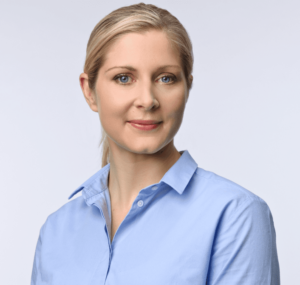October 22, 2021
By Michelle Pelletier Marshall, Global AgInvesting Media
Tanja Havemann established Clarmondial in Zurich in 2010 with the goal of creating value by proactively designing and implementing investment solutions to support sustainable natural resource management.
Clarmondial provides investment advice to leading investors, companies, foundations, conservation organizations, and governments on mobilizing concessionary and commercial resources. Recent work includes helping a leading consumer-facing company secure support from a development finance institution (DFI) for its suppliers, helping a large corporate to implement its carbon neutrality strategy through credit procurement and in-setting investments, and guiding institutional investors on their agriculture and forestry investment strategies. Clarmondial also has been working with the Marine Stewardship Council to expand the scope of their Ocean Stewardship Fund. Clarmondial manages its global activities with teams based in Switzerland, Côte d’Ivoire, Kenya, and Costa Rica.
Clarmondial developed the Food Securities Fund, an open-ended private credit fund designed for institutional investors seeking returns, liquidity, and impact. The Fund, which started operations in March 2021, is innovative in that it leverages the buying power of large corporates and a guarantee provided by the U.S. government (DFC) under USAID’s Bureau for Resilience and Food Security. Clarmondial acts as an advisor to the Food Securities Fund, which recently received a subscription from the Global Environment Facility/Conservation International in recognition of the Fund’s contribution to climate change mitigation, biodiversity, reversing land degradation, and supporting rural communities.
To understand more, GAI News reached out to Havemann at her office in Zürich.
1). Responsible investing and consideration of ESG strategy seem to be the buzzwords of ag investing at the moment. You’ve been at this for more than two decades – what shifts have you seen in ag investing because of this, and how do you see it progressing?
It is encouraging to see increasing commitments to sustainability from corporates and investors. Beyond disclosure requirements and regulations, larger corporates that drive supply chains are responding to calls for action from consumers and investors. In many cases, these corporates already observe the impact that climate change is having on their suppliers. Investors are also getting more serious about the topic and are willing to deploy capital towards sustainable investing in agriculture.
The COVID-19 pandemic has highlighted how vulnerable some supply chains are. With climate change we expect shortages and volatility in supply, and further pressure on companies is expected to increase transparency and traceability requirements in their supply chains. Sustainability factors are also increasingly important in securing business in a more competitive market environment, including for brands, intermediaries, and producers. A recent MIT report[1] confirms that large companies in particular are even more focused on supply chain sustainability post COVID-19. Large companies will have to be increasingly mindful in terms of how they engage with suppliers to incentivize longer-term relationships.
This has implications for financing and investments. Sustainability is part of operational risk management, and therefore factors into credit risk. For example, a processing company may find itself in financial difficulties if it cannot source sufficient raw material due to drought affecting agricultural output in its supply chain. Working with farmers on planting drought-resistant seeds and providing support throughout the season to implement other climate-smart practices could help stabilize that company’s supply, therefore reducing its credit risk. This is critical since traders and aggregators, in particular in emerging markets, are facing a growing credit gap – notably for working capital. This is being exacerbated as global banks and traditional lenders are pulling out of many of these markets, and of agriculture in general.
2). Can you give some examples of Clarmondial’s successes in guiding land management, forestry, or agriculture solutions/investments/portfolios?
We’ve been working with a leading coffee brand for a few years, helping them secure both concessionary and commercial financing to support sustainable supply chain initiatives. We’ve also worked with one of the largest European pension funds on aligning their agriculture and forestry investment strategy with the EU taxonomy. Institutional investors need to reconsider investment strategies and portfolios, and what information they can realistically receive from investees to comply with emerging regulations and best practice. Another example is work we have done with an agri-business, helping it structure a green bond and engage with development finance institutions (DFIs) and private impact investors. And, of course, we have a leading role in guiding the development of the Food Securities Fund, which is providing additional funding to agribusinesses in emerging markets.
3). You mention the Food Securities Fund, which was launched in March 2021. Can you please provide some details on this?
Clarmondial started working on this Fund concept about five years ago. Building on our work with large corporates and their suppliers, we noticed an increasing working capital gap. A lot of corporates have increasing sustainability commitments, but their suppliers, in particular small and medium sized enterprises (SMEs), struggle to implement them due to limited access to funding – even if they have lines with local banks and other traditional and impact lenders. We saw a market failure, where such funders cannot help, even if these suppliers have longstanding trading relationships.
We also speak regularly to many institutional investors and saw that, in the impact investing space, there’s more appetite for regulated, reasonably liquid, and well-structured products. Given where the interest rates are in many developed countries, it was interesting to design a product that can provide additional funding at competitive rates to these agricultural value chains by leveraging existing relationships with large creditworthy corporates. We understand agriculture supply chains, so we based the investment strategy on food finance[2] and supply chain architectures, instead of settling for the usual asset-backed lending model.
In addition to supply-chain related de-risking, the Food Securities Fund also has a guarantee facility from the U.S. government. It is a “blended finance fund”, combining public and private capital.
The Securities Fund enables borrowers to do more and better business with farmers throughout the entire agriculture season, increase transparency, strengthen supply chain relationships, and progress on social and environmental issues, including climate, rural employment, gender, and land management practices. We also want to see that large corporates, who have often made public commitments about their supply chains, start to take more meaningful action and support their suppliers in achieving these shared goals. They can, for example, achieve that by helping suppliers access loans from the Food Securities Fund.
4). Is there a dollar amount associated with the new Food Securities Fund?
The Fund is backed by high-profile U.S. investors, including major U.S. foundations and a family office. The Fund also received a subscription from Conservation International, as part of the $15 million commitment by the Global Environment Facility announced in September. The GEF is the multilateral fund that represents the UN Framework Convention on Climate Change, the UN Convention on Biological Diversity, and the UN Convention to Combat Desertification. And I’m pleased to say that Clarmondial has originated several transactions for the Fund, and already in its first year, the Food Securities Fund has impacted the lives of over 10,000 smallholder farmers.
5). How do you see the Fund’s efforts progressing?
We are growing the Fund’s portfolio to build its track record in financial and impact terms. Pension funds, banks, and insurance companies, as well as family offices, are already showing interest to invest. One aspect they value is that the Fund is categorized as an Article 9 “dark green” fund[3] under the European Sustainable Finance Disclosure Regulation.
Clarmondial will continue to source pipeline for the Fund, with a particular focus on sub-Saharan Africa. In addition, we are considering transactions in Latin America and Southeast Asia. Clarmondial continues to expand its partnerships on supplier financing with large consumer facing companies and traders. And, alongside the Fund, Clarmondial does see additional opportunities for helping to mobilize complementary long-term financing – for example for landscape restoration needs.
6). GAI attendees – much like your clients – are institutional investors, government agencies, family offices, entrepreneurs, and the like, seeking to mobilize investment in sustainable natural resource management. What are the top areas, such as climate finance or carbon sequestration, that you’d tell them to pay close attention to?
I would advise them to pay attention to the natural climate solutions and nature-based solutions space, and to consider ways to build climate, biodiversity, and other supply-chain related commitments into financial structures.
We are seeing that leading consumer-facing companies want to implement their climate neutrality investments in their sourcing areas and sectors. When advising clients on this, we pay special attention to integrity, voluntary vs. regulated markets, and ensuring that our clients and partners properly understand the different carbon markets.
The other related topic is blended finance. It’s gotten increasing attention lately. With the reduction in development assistance and tight government budgets, I think we’ll see more willingness from public and private funders to play a role in mobilizing additional private capital. We have hands-on experience with this, including in structuring transactions and investment vehicles, as well as in thought leadership[4]. Like climate finance, costs of blended transaction can quickly outweigh benefits if the strategy is unclear, or you don’t have the right expertise.
Finally, I think we’ll see more attention on value chain approaches, with increased investment strategies and opportunities developing around that topic.
ENDNOTES:
[2] https://www.worldbank.org/en/topic/agriculture/publication/food-finance-architecture-financing-a-healthy-equitable-and-sustainable-food-system
[3] https://www.fieldfisher.com/en/insights/light-green-and-dark-green-funds-under-the-sfdr
[4] Tanja Havemann & Christine Negra & Fred Werneck, 2020. “Blended finance for agriculture: exploring the constraints and possibilities of combining financial instruments for sustainable transitions, “Agriculture and Human Values, Springer;The Agriculture, Food, & Human Values Society (AFHVS), vol. 37(4), pages 1281-1292, December.
ABOUT TANJA HAVEMANN
 Tanja Havemann is co-founder and director of Clarmondial, an independent advisory established in 2010 to facilitate investments linked to improved natural resource use efficiency. Havemann has 20 years of experience in the environmental finance sector, including with a UK-based asset management company focused on the low carbon economy. She is a board member on various sustainability-oriented organizations and has published various reports and papers on climate and blended finance. Havemann has an LLM in Environmental Law and Policy from University of Kent, and an MSc in Applied Environmental Economics (Imperial College London), and a BSc (Hons) in Tropical Environmental Science from University of Aberdeen.
Tanja Havemann is co-founder and director of Clarmondial, an independent advisory established in 2010 to facilitate investments linked to improved natural resource use efficiency. Havemann has 20 years of experience in the environmental finance sector, including with a UK-based asset management company focused on the low carbon economy. She is a board member on various sustainability-oriented organizations and has published various reports and papers on climate and blended finance. Havemann has an LLM in Environmental Law and Policy from University of Kent, and an MSc in Applied Environmental Economics (Imperial College London), and a BSc (Hons) in Tropical Environmental Science from University of Aberdeen.
 – Michelle Pelletier Marshall is contributing editor and author for HighQuest Partners’ GAI News and Oilseed & Grain News, and managing editor for its WIA Today blog. Additionally, she is the company’s PR/Media Manager. She can be reached at marshall@highquestpartners.com.
– Michelle Pelletier Marshall is contributing editor and author for HighQuest Partners’ GAI News and Oilseed & Grain News, and managing editor for its WIA Today blog. Additionally, she is the company’s PR/Media Manager. She can be reached at marshall@highquestpartners.com.

Let GAI News inform your engagement in the agriculture sector.
GAI News provides crucial and timely news and insight to help you stay ahead of critical agricultural trends through free delivery of two weekly newsletters, Ag Investing Weekly and AgTech Intel.




